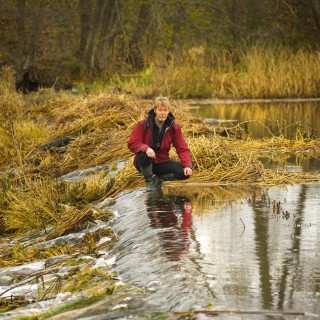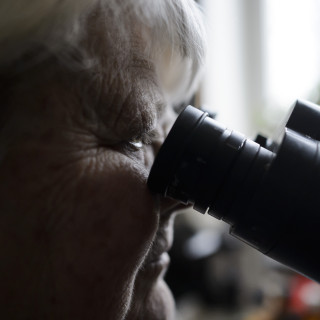Nanotracking
All animals move to look for food or to avoid different threats, and each individual must make its own choices: shall I stay, flee or move on? Large animals are fitted with transmitters so that researchers can follow their every move. But how can we study animals that are so small we can barely see them?
We see on television how wild gnus and elks are equipped with large transmitters to enable researchers to track how they move. Today, there are transmitters that are so light that they can be used to help us track small fish. But what about the fish’s food, zooplankton? What choices do they make? Researchers in the CAnMove project at Lund University are now using nanotechnology to find answers to that question.
Much movement but little detailed knowledge
“The whole idea for the project was born out of frustration and envy”, says Lars-Anders Hansson, Professor of Aquatic Ecology. “Envy of those who study larger animals and who can see where they swim, fly, crawl or run all the time. Frustration that we couldn’t study the private lives of small animals.”
One of the animal migrations, based on total biomass, is in fact by plankton – organisms so small that we can barely see them. Every day, zooplankton move up and down in lakes and the sea – up to the light to find food and down into the dark to avoid being eaten or harmed by the sun’s ultraviolet (UV) rays. By taking water samples from different depths and counting the number of plankton, researchers have been able to study how entire plankton communities migrate up and down.
“We can see that there are more here and fewer there”, says Lars-Anders Hansson. “But there is always wide variation; clearly, not all the individual animals behave the same. It is frustrating not being able to study whether this is because certain individuals never move, or if some just move more slowly.”
Cross-disciplinary collaboration provides solution
Lars-Anders Hansson decided to do something about his frustration, and invited colleagues from physics and chemistry to watch small water fleas swimming round in a container. Was there anything in the new nanotechnology that could be used to mark such small animals? Buy quantum dots, said the nanophysicists. Quantum dots are nanometre-sized structures that emit light when they are stimulated by energy, for example when they are illuminated. The size of the dots determines the colour of the light.
“With these dots, each individual flea can be marked with a unique colour or colour combination”, explains Lars-Anders Hansson.
“With these dots, each individual flea can be marked with a unique colour or colour combination.”
The next step was to attach the tiny dots to the shell of the water fleas. This was where the chemists came into the picture. After several attempts, they found a substance that could act as ‘glue’ for most zooplankton. It was then time to see how the animals reacted when their shells were covered with quantum dots.
“The fleas were not affected by the marking”, says Lars-Anders Hansson. “We saw no difference in behaviour, survival or reproduction.”
Small animals’ movements caught on camera
The water tank that is used to study the water fleas’ movements is small enough for two cameras to capture all movements on 3D images. However, it is still deep enough that a little water flea has to swim 500 times the length of its own body to get from the surface to the bottom. Special LEDs spread a weak light and make the water fleas glow in their different colours.
“The cameras take 10 pictures a second and we can now register the entire migration path and analyse how far and how fast they have swum”, says Lars-Anders Hansson.
The method has made it possible to track 10 individual fleas at the same time, in order to study whether there are differences in their behaviour. It is also possible to study competition by mixing individuals from different species of zooplankton and insects.
Lars-Anders and his colleagues have tested the method on other small creatures such as aquatic insect larvae and copepods. The quantum dots function perfectly on insects, but the researchers have not yet been able to attach them to the copepods. Lars-Anders isn’t worried though; the chemists will no doubt be able to find a solution.
“This project would not have been possible without collaboration with physicists and chemists”, he says.
Private lives of water fleas studied
The joint method development now means that Lars-Anders Hansson, his doctoral student Mikael Ekvall and postdoctoral fellow Giuseppe Bianco can start to investigate the private lives of the water fleas. One interesting question is whether differences in migration patterns that are seen in lakes and oceans could be due to different personalities of the plankton. Are some perhaps daring and others cautious? Are some individuals more willing to brave dangers such as greater UV radiation or the presence of predators for the chance to get more food?
“We can study whether the personality is passed on over multiple generations. We can also train individuals to become used to UV radiation, for example, and then compare them with untrained individuals. There are no end of possibilities”, concludes Lars-Anders.
Text: Pia Romare
Published: 2014
3D-tracking of two Daphnia magna in the absence/presence of UV radiation. Animation depicts the
behavioural response of two D. magna (labelled with red and yellow fluorescing poly-L-lysine coated quantum dots, respectively) to UV radiation. The UV radiation is introduced after 20 seconds into the tracking (journal.pone.0078498.s004).
Facts
-
Nanotechnology
-
Nanotechnology, technology for production of objects of between 1 and 100 nanometres (nm, billionths of a metre, 10-9 m), used in areas including microelectronics and biotechnology.
-
How to make a water flea glow red
-
In order to attach the fluorescent red quantum dots to the water flea’s shell, each dot must first be covered with a layer of ‘glue’. The quantum dots therefore have to lie in a bath of poly-L-lysine – a substance that is also used to attach tissue samples to the slide on a microscope. When all the quantum dots have got a sticky covering, the water fleas swim in a solution of dots. After this, each animal has a new fluorescent red ‘skin’. Because water fleas moult often, they lose their marking after a few days.





